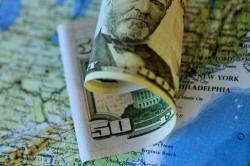Dollar lackluster before U.S. jobs data
 Send a link to a friend
Send a link to a friend
 [November 03, 2017]
By Saikat Chatterjee [November 03, 2017]
By Saikat Chatterjee
LONDON (Reuters) - The dollar steadied on
Friday, capping a week of mild losses, as investors waited for fresh
data for evidence of more strength in the U.S. economy and the progress
of tax plans to bet on the greenback's outlook.
The market showed little reaction to U.S. President Donald Trump's
appointment on Thursday of Fed Governor Jerome Powell to lead the U.S.
central bank as markets expected his leadership will signal a
continuation of Janet Yellen's cautious policies.
"Powell's appointment doesn't change anything in terms of what we expect
from the Fed over the next year and the bigger story here is that three
biggest economic blocs including China, U.S. and Europe are growing at a
strong pace together for the first time since the crisis," said Richard
Falkenhall, senior FX strategist at SEB in Stockholm.
The next big data release comes later today. The U.S. non-farm payrolls
report is expected to show job numbers bounced back in October after
September's drop.
Against a broad basket of currencies, the dollar edged 0.1 percent up to
94.77 <.DXY>, up from a one-week low of 94.411 set on Thursday.

The dollar has bounced more than 4 percent since hitting a September low
after falling more than 12 percent in the first nine months of the year.
Even longer-term skeptics of the dollar such as BNP Paribas warn against
shorting the greenback as market positioning has become more balanced
and because of the "gradual progress" of the U.S. tax reform bill.
In Washington, House Republicans also finally disclosed their
long-delayed plans for tax cuts that President Trump has promised,
setting off a frantic race in Congress to give him his first major
legislative victory.
[to top of second column] |

A U.S. Dollar note is seen in this June 22, 2017 illustration photo.
REUTERS/Thomas White/Illustration

The Australian dollar was the big loser of the day, falling half a percent after
disappointing retail sales data. The British pound dropped to a one-month low
after plunging on Thursday.
The Australian dollar slipped half a percent to $0.7666, coming under pressure
after data showed that retail sales were flat in September. That was below
market expectations for a rise of 0.4 percent on the month.
Sterling continued to fall after suffering its biggest one-day fall against the
dollar since June on Thursday, when the Bank of England raised interest rates
for the first time in more than a decade but said it sees only gradual rises
ahead.
Sterling fell 0.2 percent to $1.3040 <GBP=D3>, its lowest since Oct. 6, after
losing 1.4 percent on Thursday.
Morgan Stanley strategists said the prospect of more U.S. rate increases next
year would put pressure on currencies such as the Australian dollar and
sterling, since households in those countries have racked up large debts in
recent years.
"As the Fed continues to raise interest rates, these funding costs will rise, if
not compensated by lower borrowing costs in their home currency," Morgan Stanley
strategists said in a note.
(Reporting by Saikat Chatterjee; Editing by Larry King and Emelia
Sithole-Matarise)
[© 2017 Thomson Reuters. All rights
reserved.] Copyright 2017 Reuters. All rights reserved. This material may not be published,
broadcast, rewritten or redistributed.
 |